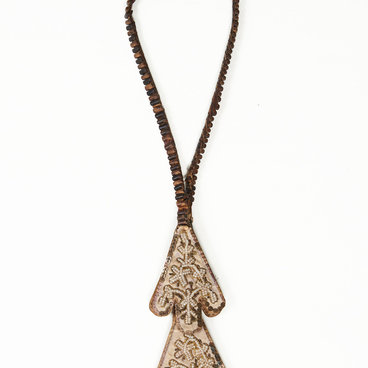This wedding suit belonged to Elizaveta Kharitonova, who lived in the village of Cherepovo near Gorodets. Her wedding took place approximately in 1913. Her husband, Alexander Kharitonov, worked as a shoemaker, and she did the housekeeping and brought up children. Elizaveta Ivanovna descended from a wealthy family which had several daughters. Her father was engaged in trade and could afford to marry his daughter off with a good dowry and in a beautiful wedding dress.
The suit was donated to the Gorodets Museum by Yevdokiya, one of Elizaveta Ivanovna’s daughters. After she graduated school, she was allocated to Syberia for work, and upon returning home, she got married and had her children. Once Yevdokiya was sorting out the trunk with her mother’s clothes and came across the wedding suit, and upon her mother’s permission, she donated it to the museum collection in 1988. First, it was exhibited in the Museum of Local History, and for the last fifteen years — in the ‘House of Countess Panina’ Museum.
The suit was of light color shade, but historically, wedding dresses were not always white. For example, in the 16th — 17th centuries, only the ‘spouse of Christ’ might wear a white dress — a girl who decided to go to a monastery and become a nun. White wedding dresses first appeared only in the 17th — 18th centuries in Europe, but they were out of the ordinary. The tradition was established in 1840 due to the most outstanding marriage ceremony of the 19th century — the wedding of the Queen Victoria of England and Duke Albert of Saxe-Coburg-Gotha. In Russia, the vogue of white wedding dresses appeared even later — at the turn of the 20th century. Nevertheless, even at that time, the cloth for wedding dresses had rather gentle pastel shades.
The wedding suit from the museum collection is made of printed silk. It was sewn according to the standards of the urban style, as by the turn of the 20th century the urban fashion eclipsed the others. This suit consists of a skirt and a jacket, which are made of the same cloth. Such suits were very popular with townswomen. Soon they were borrowed by rural women, who wanted to be in vogue, and were part of the rural wedding tradition until the middle of the last century. Dressed could be sewn from mill-finished fabrics such as silk, wool, velvet, or chintz. In addition to the dress, a bride could wear a wedding wreath with a veil and white satin or kid shoes.
The suit was donated to the Gorodets Museum by Yevdokiya, one of Elizaveta Ivanovna’s daughters. After she graduated school, she was allocated to Syberia for work, and upon returning home, she got married and had her children. Once Yevdokiya was sorting out the trunk with her mother’s clothes and came across the wedding suit, and upon her mother’s permission, she donated it to the museum collection in 1988. First, it was exhibited in the Museum of Local History, and for the last fifteen years — in the ‘House of Countess Panina’ Museum.
The suit was of light color shade, but historically, wedding dresses were not always white. For example, in the 16th — 17th centuries, only the ‘spouse of Christ’ might wear a white dress — a girl who decided to go to a monastery and become a nun. White wedding dresses first appeared only in the 17th — 18th centuries in Europe, but they were out of the ordinary. The tradition was established in 1840 due to the most outstanding marriage ceremony of the 19th century — the wedding of the Queen Victoria of England and Duke Albert of Saxe-Coburg-Gotha. In Russia, the vogue of white wedding dresses appeared even later — at the turn of the 20th century. Nevertheless, even at that time, the cloth for wedding dresses had rather gentle pastel shades.
The wedding suit from the museum collection is made of printed silk. It was sewn according to the standards of the urban style, as by the turn of the 20th century the urban fashion eclipsed the others. This suit consists of a skirt and a jacket, which are made of the same cloth. Such suits were very popular with townswomen. Soon they were borrowed by rural women, who wanted to be in vogue, and were part of the rural wedding tradition until the middle of the last century. Dressed could be sewn from mill-finished fabrics such as silk, wool, velvet, or chintz. In addition to the dress, a bride could wear a wedding wreath with a veil and white satin or kid shoes.



